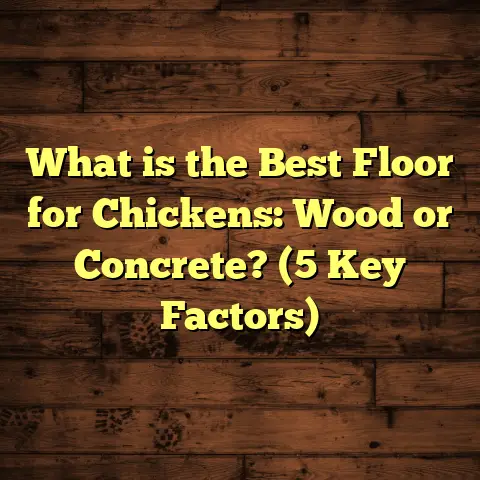What is Creaking Floors? (5 Causes You Didn’t Know About!)
What is Creaking Floors?
Let’s start simple: what exactly are creaking floors? When you walk across a floor and hear those annoying squeaks or groans, that’s creaking. It happens when parts of the floor rub against each other or move slightly out of place. This sound usually comes from friction or small movements in the floor’s structure. Sometimes it’s just a minor annoyance, but other times it points to something more serious going on beneath your feet.
From my experience, creaking floors aren’t just about the surface material. They’re a sign that your floor system—whether it’s hardwood, subfloor, or joists—is reacting to forces like weight, moisture, or time. And believe me, ignoring these sounds can lead to bigger problems down the line.
Why Does Creaking Annoy Us So Much?
Have you noticed how even the slightest creak in a quiet room can grab your attention? It’s almost like the floor is calling out to you every time you step. I find it fascinating that such small movements can produce such loud sounds. That’s because floors are made of rigid materials designed to hold weight firmly. When those materials shift or rub, the noise is amplified.
Interestingly, creaking can sometimes make people hesitant to walk barefoot or have children play freely indoors. It even affects property value in some cases because buyers associate creaks with poor maintenance or structural issues.
1. Seasonal Changes and Moisture Fluctuations
You might not guess it, but changes in humidity and temperature play a huge role in floor creaking. Wood flooring is especially sensitive because it expands and contracts as moisture levels change. I remember working on a project where the homeowner complained about creaks mainly during winter months. Turns out, the dry indoor air caused the wood to shrink just enough to create gaps and rubbing joints.
Here’s some data that backs this up: According to a study by the Hardwood Federation, wood floors can expand or contract by as much as 1/4 inch over a 12-foot span due to moisture changes. That movement might seem small, but it’s enough to cause boards to rub and creak.
It’s a bit like how your shoes make noise when they’re tight or loose—floors shift in response to their environment too. This seasonal swelling and shrinking can loosen nails or adhesive bonds, which makes things worse.
How Does Moisture Enter Your Flooring System?
Moisture can come from several sources inside your home: high humidity levels from cooking and bathing, wet shoes tracked indoors, or even leaks from plumbing. In areas with basements or crawl spaces that aren’t properly ventilated, moisture builds up underneath the subfloor and causes wood to swell.
When wood absorbs moisture, it gets bigger; when it dries out, it shrinks. This constant cycle stresses joints and fasteners holding the floor together.
In one case, I encountered a home where the crawl space had standing water due to poor drainage outside the foundation. The resulting moisture made the subfloor swell unevenly, causing loud creaks when walking above.
Preventing Moisture-Related Creaks
To keep your floors quiet through seasonal changes:
- Use humidifiers during dry winters to maintain consistent indoor humidity (ideally between 35-55%).
- Ensure proper ventilation in basements and crawl spaces.
- Fix leaks promptly.
- Use vapor barriers under flooring where recommended.
These simple steps reduce wood movement and help maintain tight joints.
2. Poor Installation Techniques
I’ve seen a lot of flooring installations throughout my career, and I can tell you that improper installation is one of the top culprits behind creaking floors. Sometimes installers rush through the job or skip crucial steps like acclimating wood before laying it down.
In one job I did, the floor was installed directly over an uneven subfloor without proper underlayment. The result? The boards didn’t sit firmly and moved when stepped on, causing persistent creaks.
According to flooring industry research, up to 30% of floor squeaks come from installation issues such as inadequate nailing patterns, poor subfloor preparation, or using the wrong fasteners. Even the spacing between boards matters—a gap that’s too tight or too wide can cause movement and noise.
What Does Proper Installation Look Like?
Good installation starts with prepping the site:
- Acclimation: Wood flooring should sit in the room for several days before installation to adjust to local humidity and temperature.
- Subfloor Inspection: The subfloor must be level, dry, and structurally sound. Any bumps or dips should be fixed before laying flooring.
- Fastening: Nails or staples should be placed according to manufacturer specs—usually every 6-8 inches along board edges.
- Expansion Gaps: Leaving space around room edges allows wood to expand without buckling or squeaking.
Skipping any of these steps increases the chance of movement that leads to noise.
Personal Story: A Lesson Learned
I once helped a homeowner who tried DIY hardwood flooring after watching some online videos. They skipped acclimating the wood and nailed boards directly onto plywood without checking for levelness.
Within weeks, their floors started creaking loudly with every step. Fixing it meant pulling some boards up, leveling the subfloor, and reinstalling with proper fasteners—definitely more work and cost than if done right the first time!
3. Subfloor Problems and Structural Movement
The subfloor is like the foundation of your flooring system. If it shifts or weakens, your floor will respond with sounds—and not the good kind. In older homes especially, I’ve noticed subfloor nails loosening or wood warping from years of stress.
A case I worked on involved a house built over 50 years ago where the subfloor had begun to separate from the joists due to age and moisture damage. The homeowners were hearing loud creaks that got worse over time.
Structural movement is tricky because it might be caused by settling foundations, changes in soil moisture outside the house, or even vibrations from nearby traffic. According to a study by the National Association of Home Builders, foundation settling affects about 10-15% of houses older than 30 years in significant ways that can cause floor movement.
If you hear popping or groaning sounds combined with uneven floors or cracks in walls, it’s a red flag indicating deeper structural issues.
How Subfloor Problems Lead to Noise
The subfloor supports both your finished floor and everything above it. If nails loosen or wood warps due to moisture exposure or natural aging, parts can move independently.
This movement creates friction between subfloor sheets or between subfloor and joists—leading to those familiar creaks.
Inspection Tips
If you suspect subfloor issues:
- Check for soft spots by pressing firmly with your foot.
- Look for gaps between subfloor sheets.
- Listen closely for louder creaks when stepping near walls or doorways (common stress points).
A professional can lift flooring panels if needed and assess joist integrity.
4. Loose Fasteners: Nails and Screws That Don’t Hold
Fasteners are small but mighty players in keeping your floor quiet. When nails or screws lose their grip over time due to wood shrinkage or repeated movement, they create gaps where rubbing happens.
I once helped fix a historic home where each step sounded like a mini earthquake. After lifting some boards, I found many nails had rusted and loosened because moisture had gotten into the subfloor area.
Research shows that using ring-shank nails or screws instead of smooth nails increases holding power by up to 300%, significantly reducing floor movement and noise over time.
If you’re dealing with creaks, checking for loose fasteners can be a quick fix—tightening or replacing them often quiets things down without a full renovation.
Why Do Fasteners Fail?
Several reasons:
- Rust: Moisture causes metal fasteners to corrode and lose strength.
- Wood Shrinkage: As wood dries out seasonally, nails may pull slightly free.
- Improper Fastening: Nails placed too shallowly or at wrong angles won’t hold well.
Fixing Loose Fasteners
Replacing old nails with screws designed for flooring is often best. Screws provide better grip and resist loosening better than nails.
Another trick I use is adding construction adhesive beneath boards to supplement mechanical fastening—this reduces movement and sound further.
5. Inadequate Underlayment or Padding
Underlayment isn’t just about comfort; it plays a critical role in sound control and stability beneath your flooring material. Skipping or using low-quality underlayment can make floors more prone to creaking.
I remember advising a client who wanted to save money by cutting corners on underlayment for their laminate floors. Within months, they were back complaining about creaks and uneven surfaces.
Studies on flooring performance show that proper underlayment can reduce noise transmission by up to 50%. It also helps distribute weight evenly and absorbs some of the stress that would otherwise cause boards to rub together.
Choosing the right underlayment depends on your floor type—cork, foam, rubber—you name it—and matching it with your subfloor conditions is key.
Different Underlayment Materials
- Foam: Common for laminate; provides cushioning but less moisture resistance.
- Cork: Natural sound insulator; great for hardwood floors but pricier.
- Rubber: Excellent noise reduction; often used in commercial settings.
- Felt: Traditional option; offers good cushioning but absorbs moisture if not protected.
Selecting an underlayment compatible with your flooring ensures stability and reduces creaking risks.
How I Handle Cost Estimation with Tools Like FloorTally
Managing costs is always on my mind during flooring projects—especially when dealing with repairs like fixing creaky floors. Accurate budgeting helps avoid surprises for me and my clients alike.
I’ve found tools like FloorTally handy for estimating material quantities and labor costs based on current local rates. It factors in waste percentages—which is important because you don’t want to order too little material—or too much either since leftover plank costs add up.
One time, while replacing part of an old hardwood floor with engineered wood planks, FloorTally helped me quickly compare costs between different wood species and finishes. That saved hours of manual calculations and gave me confidence presenting options to clients with clear price breakdowns.
Using such tools also helps me build realistic timelines because labor estimates come alongside material costs—so I can plan work phases efficiently without rushing or delays causing extra expenses.
Troubleshooting Creaking Floors: Steps You Can Take
Hearing creaks doesn’t mean immediate panic but don’t ignore them either. Here’s how I recommend tackling squeaky floors step-by-step:
Step 1: Identify Where Creaks Happen Most
Walk slowly across your floor listening carefully. Mark spots where sounds are loudest—these pinpoint problem areas needing attention.
Step 2: Check for Visible Signs
Look for gaps between boards or uneven surfaces near creaky spots. Also inspect baseboards for separation indicating expansion issues.
Step 3: Try Simple Fixes First
Sprinkle talcum powder or powdered graphite between squeaky boards—sometimes this reduces friction enough to quiet noises temporarily.
For loose fasteners accessible from below (like in basements), hammering them back firmly might do the trick too.
Step 4: Consider Professional Inspection
If noises persist or worsen despite small fixes—and especially if combined with uneven floors or wall cracks—call in a pro for detailed assessment of subfloor and joist conditions.
What About Different Flooring Materials? Do They All Creak?
Good question! Not all floors behave the same:
- Solid Hardwood: Most prone to creaking due to natural wood movement from moisture changes.
- Engineered Wood: More dimensionally stable than solid wood but still may creak if poorly installed or subfloor issues exist.
- Laminate Flooring: Typically less creaky since it’s denser composite layers glued tightly; however poor underlayment can cause sounds.
- Vinyl Floors: Rarely creak because they’re flexible sheets/planks installed over flat surfaces—but shifting underlayment can cause noises beneath them sometimes.
- Tile Floors: Usually silent if installed correctly because tiles don’t move—but cracked tiles over hollow spots can produce hollow-sounding noises mistaken for creaks.
Knowing your floor type helps diagnose noise causes faster since each behaves differently under stress.
More Insights from My Projects: Unexpected Causes I’ve Seen
Over years in this trade, I’ve encountered a few surprising reasons for floor creaks beyond common issues:
Pets Adding Stress
One client’s lively dog caused excessive jumping on hardwood floors leading to fastener loosening faster than usual—accelerating squeaks earlier than expected lifespan suggested.
Heavy Furniture Without Protection
Dragging heavy furniture across floors without felt pads damaged boards’ edges causing slight warping that created new rubbing points underfoot.
Improper Renovations
In one older home remodel I handled, previous owners removed support beams without adding replacements properly—leading joists to flex more than designed causing increased floor noise years later.
Temperature Extremes Beyond Norms
Homes in areas with extreme temperature swings may experience more aggressive wood movement than typical seasonal shifts causing accelerated wear on nails/adhesives holding floors down tightly.
Data-Backed Facts About Flooring Movement & Noise
To give you a clearer picture of how widespread this problem is:
- A survey by HomeAdvisor found that squeaky floors rank among top five common household repair complaints nationwide.
- Studies show up to 40% of hardwood floor issues relate directly to moisture-induced expansion/contraction cycles each year.
- Research comparing nail types indicates ring-shank nails reduced squeak incidents by 70% compared to smooth-shank nails over a five-year period in residential applications.
These numbers reinforce what experience has taught me—taking care early prevents costly repairs later!
How I Explain This Stuff to Clients Who Are Worried About Costs
I get it—when clients ask about fixing creaky floors, their first concern is usually money. Repair costs vary widely depending on causes:
- Simple fixes like tightening nails or adding underlayment run a few hundred dollars typically.
- Replacing damaged subfloors or joists can go into thousands depending on scope.
That’s why breaking down problems clearly helps clients make informed decisions about repairs versus full replacements—for example opting for engineered wood overlays instead of ripping out old hardwood if structure is sound but noisy boards persist.
Using tools like FloorTally lets me show cost differences upfront which builds trust because clients see all numbers transparently rather than guessing blindly at final bills later on.
Preventing Creaking Floors: What You Can Do Today
Prevention is hands-down cheaper than repair based on what I’ve seen repeatedly. Here’s my quick checklist for keeping floors quiet from day one:
- Let wood acclimate properly before installation (3–7 days depending on climate).
- Inspect/level subfloors carefully pre-installation; fix moisture issues immediately.
- Use ring-shank nails/screws plus recommended adhesives during installation; follow manufacturer specs strictly.
- Choose quality underlayment suited for your flooring type and local conditions (humidity etc.).
- Maintain indoor humidity between 35–55% year-round using humidifiers/dehumidifiers if needed.
- Avoid dragging heavy furniture; use protective pads under legs at all times.
- Schedule periodic inspections every few years especially in older homes for early signs of loosening fasteners or structural shifts.
Wrapping Up: What Has My Journey Taught Me About Creaking Floors?
To sum up without sounding too formal (promise!), here’s what sticks with me most after years handling squeaky floors:
Creaks aren’t just annoying—they’re signals telling you something needs attention beneath your feet. Whether it’s subtle moisture shifts causing wood movement or bigger issues like loose joists needing reinforcement, listening closely pays off big time in avoiding expensive surprises later on.
Taking care during installation—and ongoing home maintenance—makes all the difference between silent solid floors you enjoy walking on versus noisy ones that drive you mad after a while!
And hey… if you ever find yourself puzzling over mysterious squeaks in your home, reach out! Sharing stories about fixing these problems keeps me sharp—and who knows? Maybe your experience will help someone else finally silence those stubborn creaks too!
Have you dealt with noisy floors? What fixes worked best for you? I’d love to hear your experiences!





